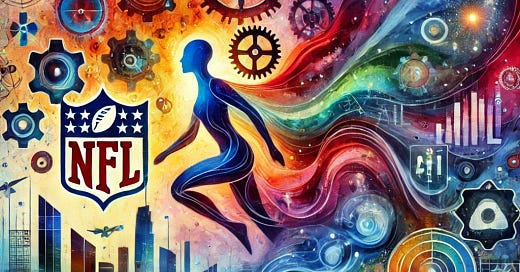Gather close. We’re living in a time where science fiction is becoming everyday life, whether we’re ready or not. Every day, new devices, inventions, and ideas roll off the assembly lines. Now, we’ve got a chip from Apple, the M4 Max, faster than anything before it, doing more than our ancestors could imagine in the blink of an eye. We marvel at it, sure. But what’s it really for? It’s still just a tool in our hands, and it’s up to us to use it wisely….Then there’s artificial intelligence. The tech whizzes tell us we’re on the verge of true machine intelligence. They say these systems could soon learn, adapt, and maybe even think for themselves. Imagine that—a machine with all the cleverness of a human, but none of the flaws, or so they hope. But let’s be honest. We’re handing over a lot of power to systems that don’t understand right from wrong. We’ve got to be careful, make sure these creations don’t outpace our own humanity….And what about Alexa, that little voice who’s been living in our homes for ten years? She’s set timers, played music, and even dimmed the lights for us. Now Amazon wants her to do more, to evolve. But here’s the thing: Alexa isn’t a person, and maybe she shouldn’t try to be. Sometimes we need to pause and think—is this technology really making life better, or just busier?
It’s not just gadgets; it’s everything. Out in the world, banks are developing bots to manage our finances, deciding where to save, where to spend. It’s efficient, sure, but what happens when these bots take on more decisions than we’re even aware of? And, in the skies, drones with “nervous systems” are flying, monitoring their own health, checking their own stress. They’re impressive, but are we ready to put our trust in machines that act on instinct rather than judgment?…And energy, well, even Amazon’s data centers are feeling the pinch. They tried to tap into nuclear power and found out that the laws of the land don’t move at the same speed as technology. Big tech wants energy, and it wants it now—but as they learned, some things are best decided with a level head and a slower pace.
My friends, we’ve got more technology than Benjamin Franklin could’ve dreamed. But it’s still up to us to steer this ship. Progress is a fine thing, but wisdom is finer still. Let’s not let the machines, or the systems, or the latest gadgets make our choices for us. Because in the end, they’re tools—and we are the masters, and that’s why you have THE COMUNICANO to read and make you wonder….
Andy Abramson
Apple Watch
The Power Within—Apple's new M4 Max chip, featured in the latest MacBook Pro, showcases impressive performance in Geekbench tests. With a multi-core score of 26,675, it surpasses Apple's previous M3 Max by 26% and even beats the M2 Ultra by 24%. Outperforming leading PC chips like AMD’s Ryzen 9 9950X and Intel's Core i9-14900K, M4 Max shows Apple’s continued edge in chip efficiency. Anticipation is high for the forthcoming M4 Ultra, which promises nearly double the M4 Max's power, likely debuting mid-2025 in Mac Studio and Mac Pro models.
AI Watch
AI and The Human Race—AI superintelligence, potentially just a decade away according to experts like Sam Altman, represents a level of intelligence surpassing human capacity. Although current AI, such as language models, shows “emerging” general capabilities, true superintelligence remains elusive due to technical challenges like insufficient human-generated data and the need for open-ended learning systems. While superintelligent AI is unlikely to “take over” in the near term, risks from autonomous systems still loom, including job displacement and dependency. Researchers emphasize the need for rigorous, multidisciplinary approaches to ensure safe development as AI progresses.
The Good, The Bad and The Ugly—AI is having a dual impact on society, with advancements in healthcare, robotics, and agriculture as benefits, but it also brings concerns like job displacement, deepfakes, and existential risks. AI’s power lies in its versatility, making it difficult to separate its positive contributions from potential harms. Ultimately, it suggests that while AI’s risks are real, abandoning its development isn’t viable. Instead, society should strive to harness AI’s potential responsibly, advocating for safeguards to mitigate its downsides without stalling innovation. The choice isn’t about taking sides but finding a balanced approach.
It’s Being Delayed—OpenAI CEO Sam Altman confirmed there will be no GPT-5 release in 2024, shifting focus instead to a model called GPT-o1 (previously "Project Strawberry"). Unlike previous versions, GPT-o1 is designed to handle complex, research-oriented tasks, emphasizing deliberate problem-solving. OpenAI aims to evolve ChatGPT into a more autonomous tool capable of performing actions without human prompts, such as booking tickets or managing service requests. Additionally, OpenAI hints at enabling adult content in the future, but it's not an immediate priority. Recently, OpenAI also introduced a search tool within ChatGPT for Plus and Teams subscribers, targeting information traditionally sought via search engines.
Search Me—You can integrate AI chatbots like ChatGPT and Perplexity as search alternatives in Chrome. By installing extensions, users can ask questions directly from their browser and receive instant, conversational answers, bypassing traditional Google results. By setting up custom search shortcuts within Chrome, users can type queries directly to these AI tools. This shift to AI-based search promises faster, more tailored responses and aims to minimize the clutter of ads and irrelevant links
My Bot Will Call Your Bot—At Money 20/20, industry experts highlighted a future where customer and provider "bots" streamline financial services. Customer bots will manage personal finances in real-time, optimizing decisions on credit and expenses. Meanwhile, provider bots will offer tailored products and negotiate with competitors’ bots. This shift could diminish brand loyalty, making banks resemble utilities focused on identity verification. The approach aims to reduce customer inertia, enabling continuous refinancing and personalized financial services. However, challenges remain, including regulatory hurdles and potential impacts on traditional financial relationships.
Amazon Watch
Power Denied—The U.S. Federal Energy Regulatory Commission (FERC) rejected a proposed agreement allowing Amazon to use more nuclear power from Talen Energy’s nearby Susquehanna plant for its data center. The 2-1 decision halted plans to increase power from 300 to 480 MW, citing insufficient justification under federal guidelines and concerns about grid reliability. While FERC Chairman Willie Phillips dissented, arguing this setback could impact energy reliability and security, opponents worried about potential rate hikes for other customers. This ruling affects big tech's push for dedicated, high-capacity power sources like co-located nuclear facilities.
To Your Health—Amazon’s healthcare business, aims to leverage the company’s strengths in efficiency and customer reach rather than to “fix healthcare” broadly. Amazon has streamlined its focus with three key initiatives: Amazon Pharmacy for online prescription sales, One Medical for in-person primary care (acquired in 2023), and virtual care services under the "Amazon One Medical Pay-per-visit" brand. These services are integrated to enhance accessibility and ease for Amazon's vast Prime customer base. With a unified tagline, “healthcare just got less painful,” Amazon underscores its identity by prioritizing convenience across these health services.
Alexa At 10—Reflecting on Alexa's 10-year journey, the author sees Amazon's voice assistant as transformative yet stalled. Initially a novelty, Alexa became integral to daily routines, especially with complex automations enhancing convenience in households. Alexa’s success grew as Amazon opened the platform to third-party Skills, expanding its reach. However, issues have surfaced: the app's clunky interface, unreliable Skills, and privacy concerns dampen its utility. Now, Alexa seems to have plateaued, with Amazon considering a "Banyan" project—a subscription-based, AI-enhanced assistant. While Amazon aims for profitability, the author argues Alexa’s future lies more in smart home dominance than as a shopping assistant.
Battery Watch
Having A Longer Life—Battery technology is evolving, with solid-state batteries (SSBs) and high-silicon anode lithium-ion cells leading the charge. Companies like Factorial and QuantumScape focus on SSBs with solid electrolytes to prevent dendrite formation, offering lightweight, high-energy solutions. Meanwhile, Group14’s high-silicon anodes boost energy and power density, enabling ultra-fast charging for conventional lithium-ion cells. Both approaches promise major gains, though each faces industrialization hurdles. As automakers test these innovations, the EV battery landscape is on the brink of transformation, potentially overcoming limitations of today's lithium-ion technology and advancing electric vehicle efficiency and performance.
Space Watch
Filler Up—SpaceX is set to attempt a crucial in-orbit refueling test between two Starships by March 2025, a milestone essential for NASA's Artemis program. This demonstration, part of SpaceX's $4.05 billion NASA contract, aims to establish Starship's capabilities for a planned 2026 crewed lunar landing. Unlike NASA's traditional Space Launch System (SLS) — a costly, single-use rocket developed under "cost-plus" contracts — the Human Landing System (HLS) program with SpaceX operates on a fixed-price model with flexible requirements. This allows SpaceX to propose additional milestones, like the upcoming propellant transfer, marking a transformative step in space exploration.
Robot Watch
How Weird Can They Get—Robots are getting weirder as they edge closer to human-like behaviors, and the list of standout bots in 2024 highlights just how surreal they’ve become. Ameca, the humanoid with “emotions,” leads the pack, while Boston Dynamics’ ATLAS robot shows off uncanny athleticism. ARTEMIS, a would-be soccer pro, and Neo Beta, a home helper with a blank stare, underscore robots’ gradual immersion into daily life—albeit awkwardly. Meanwhile, some bots like Slothbot and VERO tackle niche tasks with charm, from ecosystem monitoring to beach cleaning. These robots each add their own quirks to a future where humanoid automation feels closer than ever.
Drone Watch
It Has Feelings—Researchers at the University of Southampton have tested a groundbreaking drone equipped with an optical fiber-based "nervous system," which continuously monitors the drone's structural integrity in real-time, much like human nerves. This system uses light, rather than electrical signals, to transmit data, avoiding interference issues. By employing optical speckle techniques, it generates visual representations of the drone's stress levels, allowing AI to assess its health without frequent landings. This technology, which can potentially extend flight times and reduce maintenance costs, holds promise for applications in logistics, emergency response, and is aimed for commercialization by 2025.
Starbucks Watch
Here Come The Sharpies—New Starbucks CEO Brian Niccol is reviving the brand’s personal touch by reintroducing hand-written names and notes on coffee cups, a classic tradition requiring 200,000 Sharpies to implement at scale. Alongside this nostalgic touch, Niccol is refocusing on Starbucks’ core identity, simplifying the menu, reintroducing self-serve condiment bars, and eliminating extra charges for nondairy milk. To address app-order wait times, he’s introducing measures to balance mobile orders with in-store service, aiming to streamline customer experiences and reduce order abandonment rates. Niccol’s approach blends efficiency improvements with a nostalgic return to Starbucks’ roots.
Wine Watch
Is There Ever Too Much Wine—The wine industry faces a unique crisis: declining global wine consumption has created an oversupply, with production far outpacing demand. In 2023, consumption dropped to 221 million hectoliters, down from 247 million in 2017—equivalent to about 3.5 billion fewer bottles. Baby Boomers, historically the primary wine consumers, are buying less, while younger generations are embracing trends like “Dry January” and “Sober October,” alongside cost-saving habits. In response, wineries are closing, leaving grapes unpicked, and considering pivots to non-alcoholic offerings. Industry campaigns, like “Come Over October,” aim to reinvigorate wine culture and appeal to younger audiences.






